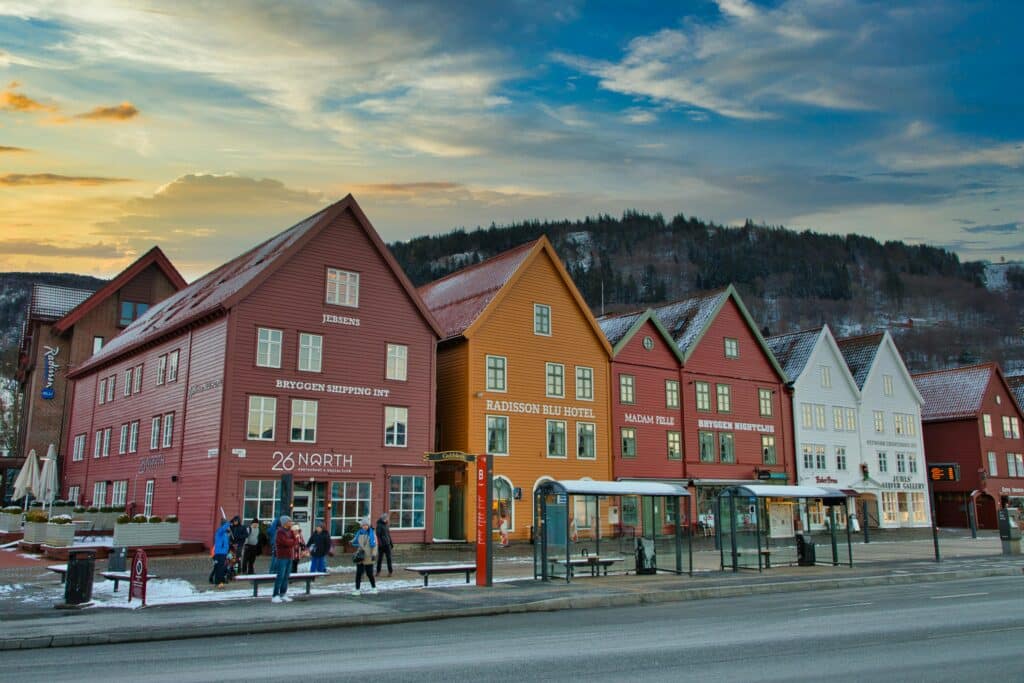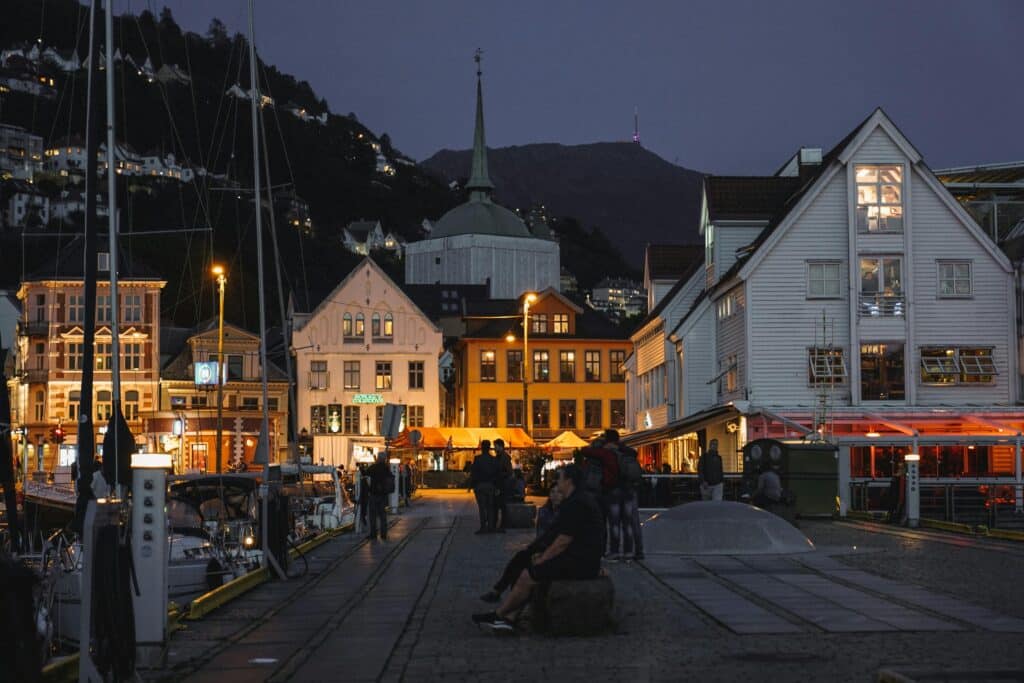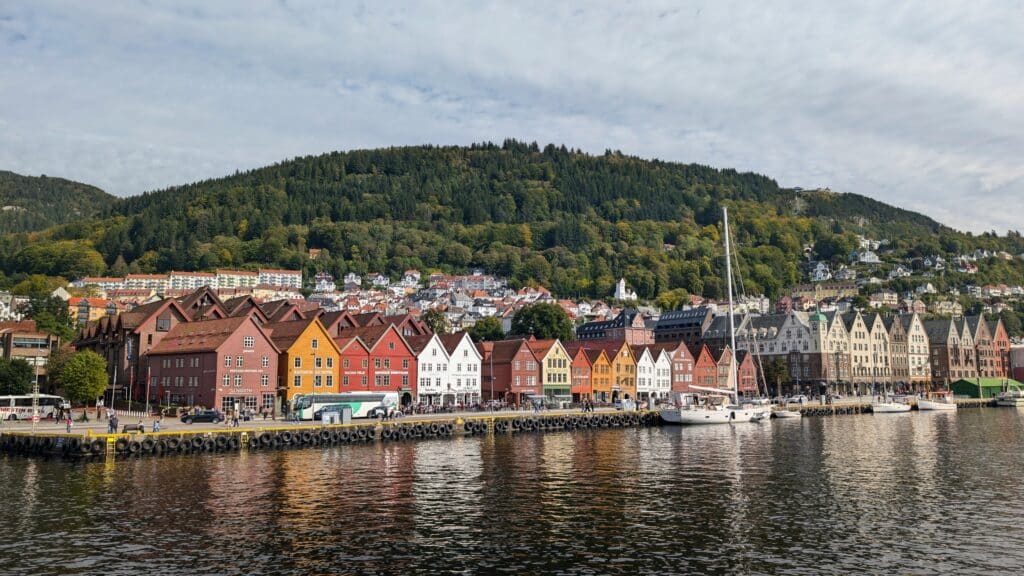
Welcome to Bergen, a city that feels like a cozy embrace from the moment you arrive. When my best friend immigrated to this charming city, I couldn’t wait to visit her. It’s truly one of the most picturesque places I’ve ever seen. Known as the “Gateway to the Fjords,” Bergen offers a delightful mix of rich history, modern convenience, and breathtaking natural beauty.
Moving to a new city is always a big step, but this Remitly guide will help you settle in and enjoy your new life in Bergen.
Table of Contents
Quick facts about Bergen, Norway
- Immigrants to Norway: over 60,000 annually (about half of whom arrive seeking asylum)
- Population of Bergen: 285,000
- International population: 16%
- Universities: 25,000+ university students, mainly at the University of Bergen (14,000+ students)
- Climate: 240 rainy days per year (famous for being the rainiest city in Norway)
- Major industries: maritime, aquaculture, energy, and tourism
Getting to know Bergen
Located on the west coast of Norway, Bergen is the country’s second-largest city. Its combination of historic charm and modern amenities means you can stroll through a medieval wharf with colorful wooden houses (Bryggen, listed as a UNESCO World Heritage site) and then pop into a trendy café for a coffee.
The city’s history dates back to its founding in 1070, when it was named Bjørgvin, “the green meadow among the mountains.” As a major hub for the Hanseatic League, a powerful force in medieval commerce, Bergen played a crucial role in trade across Scandinavia and Europe as a whole. The city also served as Norway’s capital for over 200 years until Oslo became the capital in 1299.
Today, Bergen is a hub for maritime industries like shipping and aquaculture, but it’s also known for its quality of life and its rich culture. Plus, let’s not forget the breathtaking natural beauty that surrounds you—whether you’re hiking up Mount Fløyen or taking a ferry through the fjords, Bergen’s landscapes never fail to inspire.
Where to live in Bergen
One of the first things on your to-do list will be finding a place to live. Bergen offers a variety of neighborhoods, each with its own unique vibe.
Boroughs:
- Central Bergen (Bergenhus): vibrant, with shops, restaurants, and historical sites
- Laksevåg: suburban feel, close to the city center
- Årstad: includes Nattland, popular with students and families; near the University of Bergen and well-connected by public transport
- Fana: residential and family-friendly, with good schools and outdoor spaces
- Fyllingsdalen: affordable, with a mix of apartments and houses, close to nature
- Ytrebygda: modern, with easy access to Bergen Airport and business districts
- Arna: quiet and more rural, with beautiful scenery and a strong community feel
- Åsane: growing area with shopping centers and newer housing developments
The average rent in the city center runs about 10,000-15,000 NOK for a one-bedroom (approx. 850-1250 EUR or 950-1400 USD). When renting in Bergen, expect to pay a deposit of one to three months’ rent.
Be sure to check out websites like Finn.no and Hybel.no, and local agencies, to find your perfect spot. And if you’re planning on buying a property, websites like RE/MAX or Norwegian Property can be helpful—just be sure to get familiar with Bergen’s property market first.

Public transport in Bergen
Bergen is a walkable city, but when you need to travel further, its public transportation system has you covered. This extensive network includes:
- 300+ bus routes
- Light rail line (Bybanen)
- Ferries to other parts of Norway
The buses and the Bybanen or light rail, both managed by transportation company Skyss, are reliable, clean, and easy to navigate. The Bybanen connects the city center to various suburbs and even the airport, making it ideal for both commuting and sightseeing.
For those wanting to enjoy the scenic views of the fjords, Bergen’s ferries are a fantastic option. Ferries operate both within the city and to nearby destinations, offering a unique way to experience the stunning coastal landscapes.
Driving in Bergen
If you prefer to drive, you can use a foreign driver’s license for up to three months. After that, you’ll need to obtain a Norwegian driving license. Depending on your country of origin, you may be able to exchange your current license for a Norwegian license, or you may need to take a driving course. Check the Norwegian Public Roads Administration to find out what applies to you.
Parking in Bergen can be tricky, as street parking is limited and usually paid. There are also toll roads when entering the city. For those who enjoy cycling, Bergen is bike-friendly, but it’s a good idea to invest in a bike lock to avoid theft.
Healthcare and other essentials
Once you’ve secured your new home, the next step is getting your essential services sorted. One of the first things you’ll need is a national identity number or “fødselsnummer,” (birth number) with the Norwegian Tax Administration. This number is required for accessing various services in Norway, including opening a bank account.
Norway’s healthcare system—including Bergen’s Haukeland University Hospital—is among the best in the world, offering universal coverage through the public National Insurance Scheme (NIS). Private health insurance is available but rarely necessary, as the public system offers excellent care for all. Most services, including emergency care, childbirth, and treatment for children under 16, are covered.
Finding a doctor is straightforward—once you register with the National Registry, you can choose your general practitioner from an approved list. Although healthcare isn’t entirely free, costs are manageable, with most people only paying a small annual deductible.
If you have kids, you’ll be pleased to know that Norway has an outstanding education system. From public schools to international schools, your children will be well cared for.
Banking services
Opening a bank account in Bergen is a straightforward process but does require a few essential documents, including:
- your national identity number
- your residence permit
- a valid passport
Norwegian banks are generally very user-friendly, and most offer services in English to help make your transition smoother. The main banks in the area are DNB, Nordea, Sparebanken Vest, SpareBank 1, and Danske Bank.
Cost of living in Bergen
The cost of living in Bergen can be a bit high, so budgeting will be key to making the most of your money. Groceries, housing, and eating out are on the expensive side, but there are ways to manage. Shopping at discount supermarkets, cooking at home, and taking advantage of the many free outdoor activities—like hiking or exploring the city’s parks—can help stretch your budget further.
If you’re sending money back home, consider using Remitly for reliable money transfers with competitive rates and low fees.
Getting to know people in Bergen
Moving to a new city can feel lonely at first, but Bergen offers plenty of opportunities to connect and build a social network. There are several active Facebook groups specifically for expats, where you can get advice, share experiences, and find events tailored for newcomers.
Bergen’s cultural scene is rich and varied. Whether you enjoy theater, live music, or exploring art galleries, the city has something for everyone. The dining options are equally diverse, ranging from traditional Norwegian foods to international cuisine.
If you like a good night out, you’ll find cozy pubs, lively bars, and even occasional street festivals that bring the community together. As the Norwegians say, “Så koselig!” (This common phrase is difficult to translate exactly, but means something like, “So cozy!”)
Language cafés, often run by volunteers, offer a relaxed environment to practice your Norwegian and meet both locals and fellow immigrants. The Bergen Red Cross also hosts sessions for language practice, making it easier to integrate.

Moving to Bergen with kids
Bergen is a treasure trove for families, offering endless adventures for children of all ages. I remember joining my best friend and her kids for a day at the Bergen Aquarium, the largest aquarium in Norway. If you have little ones, another must-visit is VilVite, an entirely hands-on science museum.
For younger kids, several organizations offer “åpen barnehage” (open kindergarten), which are community-run centers where parents and children can play, learn, and socialize. They’re a fantastic way to help your little ones (and yourself!) learn the language and adapt to the Norwegian way of life.
Working or studying in Bergen
Bergen is a city of opportunities, whether you’re looking to further your education or advance your career. The job market is strong, particularly in sectors like maritime industries, energy, and technology. Work culture in Norway tends to value a healthy work-life balance.
If you’re moving to Bergen on a work permit, check out job search engines such as Finn.no, Jobbnorge, Indeed, and NAV. LinkedIn is a great resource as well.
The city is also home to multiple universities that are well-regarded among European higher education institutions, including the University of Bergen, which attracts students from all over the world. If you’re planning to study, make sure you understand the visa requirements and take advantage of the many student support services available.
Practical tips for newcomers
Moving to a new city has its challenges, but it helps to be prepared:
- Safety: Bergen is very safe, though it’s wise to be aware of bike theft and other minor issues.
- Sunday closures: Most stores, including supermarkets, are closed on Sundays—plan your shopping ahead.
- Local etiquette: Norwegians are reserved but friendly. Remember to take off your shoes when entering homes and be punctual in social and professional settings.
Lastly, don’t hesitate to use local resources like websites, apps, or helplines. Bergen is well-equipped to support newcomers, and help is always available if you need it.
FAQ
Yes, most people in Bergen speak English fluently, especially in professional and social settings. However, learning some basic Norwegian phrases can go a long way in daily interactions.
Bergen is one of the more expensive cities in Norway, with high costs for housing, food, and dining out. However, careful budgeting and taking advantage of free or low-cost activities can help manage expenses.
Bergen is known for its frequent rain and mild temperatures throughout the year. Expect a lot of rainy days, especially from October to March. Summers are relatively cool, with temperatures rarely exceeding 20°C (68°F). Dress in layers and keep an umbrella handy.
Networking is key, so attending professional events and joining expat groups can be helpful. Websites like Finn.no, Jobbnorge, Indeed, NAV, and LinkedIn are also great for job listings.
Bryggen: a UNESCO World Heritage site with historic wooden buildings and a vibrant waterfront
Mount Fløyen: reachable by the Fløibanen funicular (cable car) for panoramic views
Mount Ulriken: the tallest mountain in Bergen, perfect for hiking
Fantoft Stave Church: a reconstructed medieval stave church (wooden church) with picturesque surroundings
Bergen Fish Market: a lively market offering fresh seafood and local specialties
Bergen International Festival: a two-week music and culture festival in late May and early June
Kode Art Museums: featuring works by Edvard Munch
Edvard Grieg’s home in Troldhaugen: explore the residence of the famous composer
Bergen Aquarium: Norway’s largest aquarium
VilVite: an interactive science museum that’s perfect for kids and families
Your journey to Bergen is just beginning, and there’s so much to look forward to. With its lively atmosphere, friendly residents, and spectacular views, Bergen is ready to welcome you with open arms. Keep an open mind and a sense of adventure, and you’ll soon find yourself falling in love with this beautiful city.
